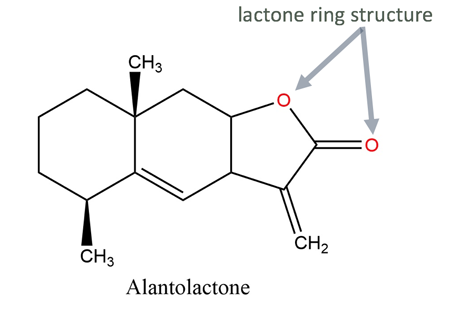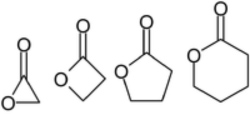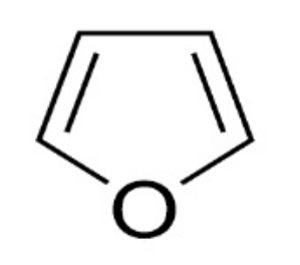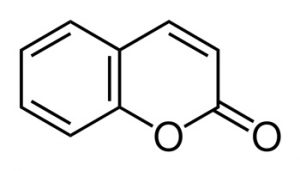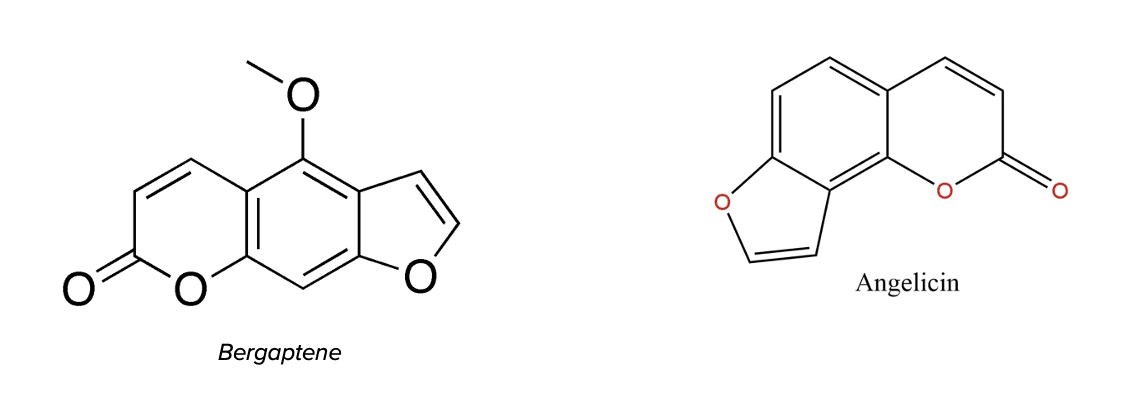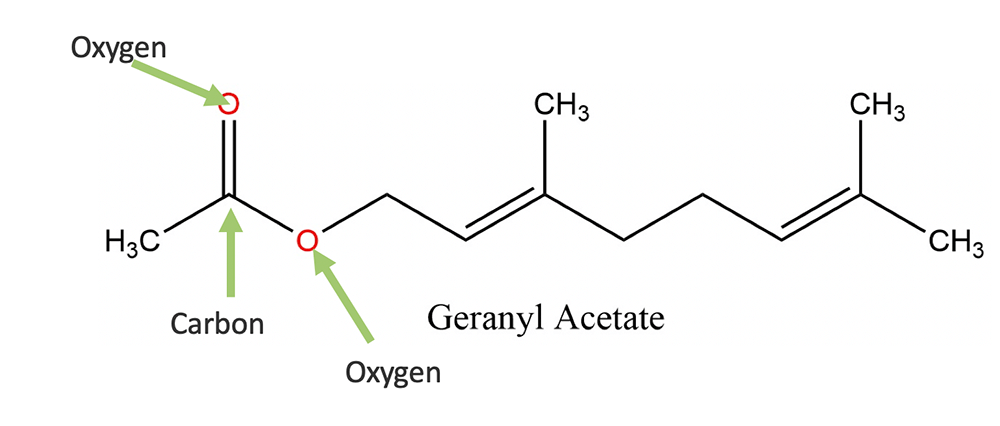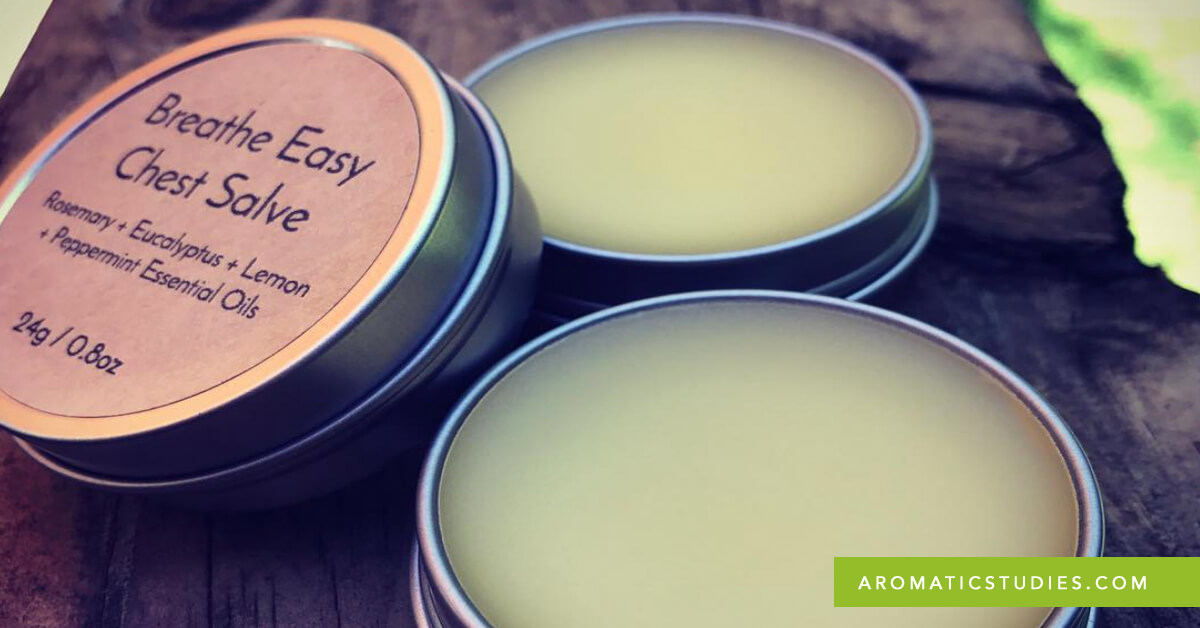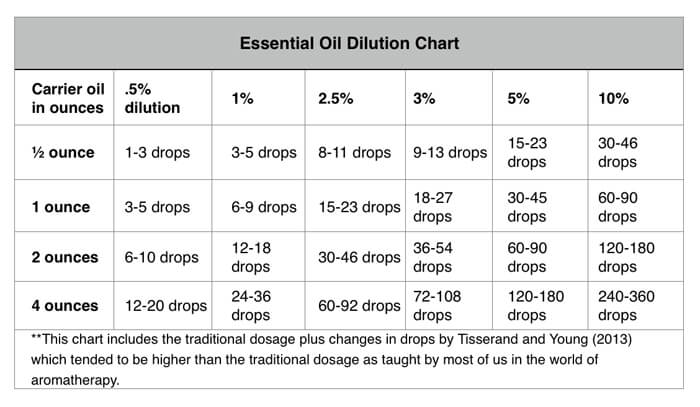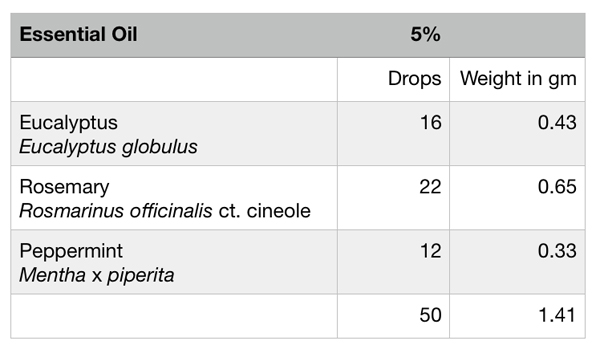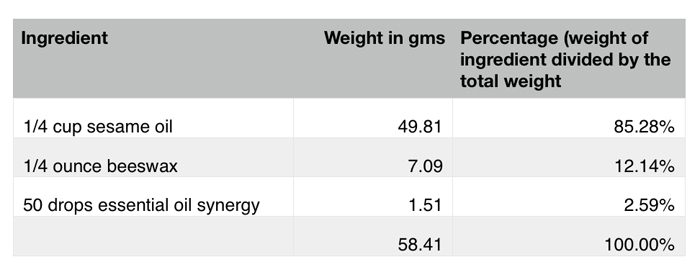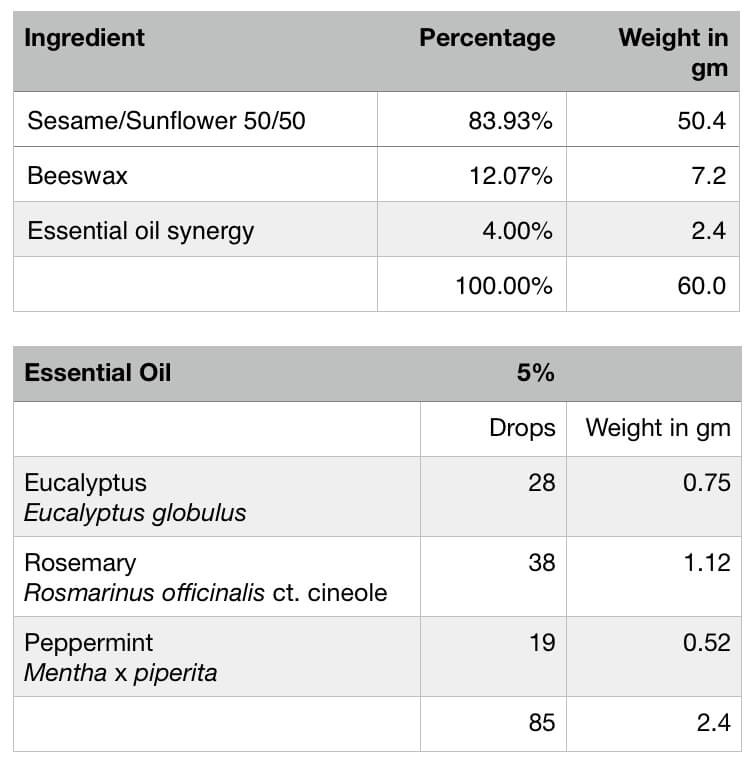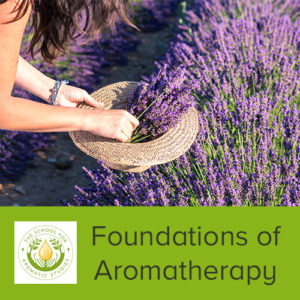Please note:
All references for each lesson throughout this course are available on the individual Lesson PDF file. We have not included them in the online lesson so as to save space.
Foundations of Aromatherapy
Lesson 7: Sesquiterpene lactones and Furanocoumarins
About Sesquiterpene Lactones
Sesquiterpene lactones are a subcategory of sesquiterpenes that have a characteristic lactone ring, a structure derived ultimately from farnesyl pyrophosphate.1
The lactone ring structure can look as follows:
Sesquiterpenes lactones are uncommon in essential oils but are found as the bitter principle in many of the plants belonging to the Asteraceae family, including Achillea millefolium, Arnica montana and Tanacetum annum.
Sesquiterpene lactones are only slightly soluble in water, slow to volatilize, and do not readily oxidize.
Lactone compounds have names which end in –lactone or –ine.
Physical characteristics of sesquiterpene lactones:
- Polarity: relatively non-polar molecules
- Solubility: generally lipophilic (fat-soluble)
- Volatility: low volatility, less volatile than monoterpenes
- Boiling point: higher boiling point than monoterpenes
- Aroma: aroma is linked to taste (bitterness)
- Color: typically, colorless
Sesquiterpene lactones found in essential oils
| Component | Essential Oil |
|---|---|
| alantolactone | Inula helenium, Inula graveolens |
| isolantolactone | Inula helenium, Inula graveolens |
| matricin | German chamomile (Matricaria recutita), Yarrow (Achillea millefolium) |
*Matricin is a nonvolatile sesquiterpene lactone and is a precursor to chamazulene. Matricin is found in the CO2 extract of German chamomile. Matricin is converted to chamazulene during distillation.
Monoterpene lactone:
- nepetalactone: Catnip (Nepeta cataria)
General therapeutic actions of sesquiterpene-lactones:
- Powerful mucolytic and expectorant activity
- Antifungal
- Antibacterial
- Antiparasitic
- Antispasmodic
- Anti-infectious
- Anti-inflammatory
- Anticarcinogenic
Essential oils containing monoterpene lactones:
- Catnip (Nepeta cataria): 4a-α,7-α,7a-β-Nepetalactone (55-70.4%), 4a-α,7-β,7a-α-Nepetalactone (2.5-31.2%), 4a-α,7α,7aα-nepetalactone (6%) In separate report: The major components of N. cataria oil were 4a-α,7-α,7a-β-nepetalactone (28.8%), 1,8–cineole (13.5%), 4a-α, 7-β, 7a-α-nepetalactone (11.9%), (E)-caryophyllene (5.7%) and citronellyl acetate (5.2%).
General therapeutic actions of nepetalactone:
- Insect repellant
- Calming, sedative
Essential oils containing sesquiterpene lactones:
- Inula (Inula graveolens): rich in esters, alcohols and small amounts of alantolactone and isolantolactone.
Core therapeutic indications for inula:
- pathologies of the mucous membranes
- bronchial spasms, bronchitis, chronic obstructive pulmonary disease
- chronic obstructive bronchitis
- spasmodic coughing
- emphysema
About Furanocoumarins Powerpoint Presentation
Coming soon!
PDF file: About Furanocoumarins Presentation
About Furanocoumarins
Furanocoumarins are derivatives of coumarin. Furanocoumarins have a five-membered ring attached to a coumarin structure.
The five-membered ring structure looks like this:
And the coumarin structure looks like this:
There are two types of furanocoumarins:
- linear: the furan ring is attached at C(6) and C(7). Linear furanocoumarins include psolaren, xanthotoxin, bergapten and isopimpinellin.
- angular: the furan ring is attached at C(7) and C(8). Angular furanocoumarins include angelicin, sphondin, and pimpinellin.1
It tends to be the linear furanocoumarins, such as bergapten, that can be troublesome to humans since they can cause photosensitization towards UV light, resulting in sunburn or serious blistering, although angelicin is also a photosensitizer. Used medicinally, this effect may be valuable in promoting skin pigmentation and treating psoriasis.
Bergapten is the most common furanocoumarin (in e/o’s) and is responsible for the photosensitizing action of bergamot and other citrus essential oils.
Physical characteristics of furanocoumarins
- Polarity: mixed to moderate polarity
- Solubility: lipophilic (fat-soluble), poor solubility in water
- Volatility: relatively non-volatile* and more prone to degradation at high temperatures
*Due to their low volatility, furanocoumarins are more often found in the expressed essential oils rather than the distilled essential oil. - Boiling point: due to their nonvolatility, furanocoumarins do not come across during the distillation process. Furancoumarins are found in the cold pressed citrus essential oils.
- Aroma: no distinct aroma
- Color: colorless to pale yellow
Note: Understanding Bergaptene in Bergamot Essential Oil
Bergaptene is a naturally occurring compound in bergamot fruit peels that belongs to a class of substances called furanocoumarins. This compound is non-volatile, meaning it has a heavy molecular weight that prevents it from evaporating easily.
When bergamot essential oil is produced through the traditional cold-pressing method, bergaptene remains in the final product at concentrations typically ranging from 0.11% to 0.32%. Cold-pressing is the preferred extraction method for bergamot because it preserves the oil’s superior fragrance quality and beneficial aromatic compounds.
In contrast, when bergamot is processed through steam distillation, the resulting oil naturally contains no bergaptene. This occurs because the compound is too heavy to carry over with the steam during the distillation process.
However, steam distillation is rarely used as the primary method for producing bergamot essential oil because it yields a product with reduced olfactory quality and fragrance complexity compared to cold-pressed oil.
For commercial applications where bergaptene-free oil is desired, producers use specialized refining processes on cold-pressed bergamot oil. One method involves treating the oil with an alkaline solution that chemically modifies the bergaptene structure, followed by separation and purification steps. Another approach uses vacuum fractional distillation, which operates at lower temperatures and reduced pressure to selectively remove bergaptene and other furanocoumarins while preserving the oil’s valuable aromatic components. These refined products are labeled as either “bergapten-free” (containing less than 30 parts per million of bergaptene) or “furocoumarin-free” (FCF), with the latter removing all furanocoumarin compounds, not just bergaptene. These specialized oils maintain much of the characteristic bergamot fragrance while eliminating the photosensitizing properties associated with bergaptene.
Furanocoumarins found in essential oils:
angelicin: Angelica root
bergapten: Bergamot (expressed), Expressed lime, Expressed lemon, Grapefruit, Mandarin
General therapeutic actions of furanocoumarins:
- Photosensitizers
- Antimicrobial
Essential oils containing Furanocoumarins
- Angelica root (Angelica archangelica): small amount of angelicin (less than 1%)
- Bergamot (Citrus bergamia): small amount of bergapten (up to 0.33%)
- Expressed lime (Citrus aurantiifolia): bergapten (0.17-0.33%)
- Expressed lemon (Citrus limon): bergapten (.0001-0.035%)
- Grapefruit (Citrus paradisi): bergapten (0.012-0.019%),
- Mandarin (Citrus reticulata): bergapten (0-0.0005%)3
Safety notes for essential oils containing furanocoumarins
- Essential oils containing furanocoumarins exhibit phototoxic effects. Phototoxic or photosensitizing compounds are substances which can causes rapid tanning or burns under the influence of ultraviolet light. Furanocoumarins are able to absorb ultraviolet light thereby producing a burning or tanning effect on the skin.
- Recommended dosage of angelica root essential oil is: 0.8% to avoid phototoxicity and 0.4% for bergamot essential oil.4
- It would also be prudent when using essential oils containing phototoxic furanocoumarins that the client be asked to avoid direct sun or sun-beds for a minimum of 12 to 24 hours.
- The use of furanocoumarin-free bergamot is recommended for internal use.
| Table 1.3 Photosensitizers | |
|---|---|
| Essential oil | Latin name |
| Angelica root | Angelica archangelica |
| Bergamot | Citrus bergamia |
| Cumin | Cuminum cyminum |
| Distilled or Expressed Grapefruit (low risk) | Citrus paradisi |
| Expressed Lemon | Citrus limon |
| Expressed Lime | Citrus x aurantifolia or Citrus x latifolia |
| Expressed Bitter Orange | Citrus aurantium |
| Rue | Ruta graveolens |
How to use Photosensitizing Essential Oils Safely
| Essential Oil | Maximum dilution | Drops |
|---|---|---|
| Bergamot, cold pressed (Citrus bergamia) | 0.4% | 2 drops per fl oz |
| Bitter Orange, cold pressed (Citrus aurantium) | 1.25% | 7 drops per fl oz |
| Grapefruit, cold pressed (Citrus paradisi) | 4% | 24 drops per fl oz |
| Lemon, cold pressed (Citrus limon) | 2% | 12 drops per fl oz |
| Lime, cold pressed (Citrus aurantifolia) | 0.7% | 4 drops per fl oz |
| Angelica root (Angelica archangelica) | 0.8% | 4 drops per fl oz |
Notes on other citrus essential oils:
- Distilled lemon is safe but rare
- Distilled lime is safe
- Sweet orange is safe!
Lesson 3a: Esters
About Esters Powerpoint Presentation
Download Esters Powerpoint (US letter size)
Download Esters Powerpoint (A4 paper)
About Esters
Esters are the product of a chemical reaction that commonly occur between an alcohol and an organic acid. Esters are mildly polar compounds with characteristically intensely fruity aromas. They have a similar boiling point as alcohols or ketones of similar molecular weight and are somewhat soluble in water.
An example of an ester forming would be:
acetic acid + linalool = linalyl acetate + molecule of water
Esters have the general formula R-COO-R.
Esters have names which end in –ate or ester.
Examples of esters found in essential oils
bornyl acetate, methyl salicylate, geranyl acetate
linalyl acetate, isobutyl angelate, thymol acetate
menthyl acetate, benzyl acetate, citronellyl acetate
methyl benzoate, eugenyl acetate, vetiverol acetate
sabinyl acetate, terpineol acetate
General therapeutic actions of esters:
- Anti-inflammatory
- Powerful antispasmodic (smooth muscle spasms)
- Analgesic
- Direct effect on the central nervous system (CNS): relaxing, balancing
- Release muscular and nervous tension
- Soothing to dermal inflammation
- Sedative
- Hypotensive
Core therapeutic indications for ester-rich essential oils:
- Spasms of any kind
- Nervous system (anxiety, depression, stress)
- Inflammatory conditions
Ester-rich essential oils
- Lavender (Lavandula officinalis)
- Bergamot (Citrus bergamia): cold pressed and distilled
- Clary sage (Salvia sclarea)
- Petitgrain (Citrus aurantium var amara – leaf)
- Hemlock (Tsuga canadensis)
- Black Spruce (Picea mariana)
- Inula (Inula graveolens)
- Valerian (Valeriana officinalis)
Safety notes for ester-rich essential oils
- Esters are nontoxic at physiological and therapeutic doses.
- Ester-rich essential oils are safe to use via all routes of administration.
Safety for specific components
- Methyl salicylate: Internal use of methyl salicylate-rich essential oils should be avoided in gastroesophageal reflux disease, and salicylates are contraindicated in children due to the risk of developing Reye’s syndrome.4 Do not use birch or wintergreen on infants, on damaged skin. Avoid use of methyl salicylate-rich essential oils with or individuals on other salicylate-based medication or who are currently taking warfarin. Topically applied methyl salicylate can potentiate the anticoagulant effects of warfarin, causing side-effects such as internal hemorrhage.
Additional Notes on Methyl salicylate
Toxicity of Methyl salicylate
One teaspoon of the essential oil of wintergreen is equivalent to approximately 7000 mg of salicylate or 21.7 adult aspirin tablets. Ingestion of as little as 4ml in a child can be fatal.
Ingestion of methyl salicylate poses the threat of severe, rapid-onset salicylate poisoning because of its liquid, concentrated form and lipid solubility. Methyl salicylate in topical analgesic preparations may cause irritant or allergic contact dermatitis and anaphylactic reactions.
Topical methyl salicylate ointment should be prescribed with care to patients on warfarin and excessive usage is to be avoided since potentially dangerous drug interaction could occur. Excessive usage of these preparations in patients receiving warfarin may result in adverse interactions and bleedings.
A considerable amount of salicylic acid may be absorbed through the skin after topical application of methyl salicylate products and this may increase with multiple applications. Caution is warranted in patients for whom systemic salicylate may be hazardous or problematic.
NOTE: Birch and Wintergreen essential oils contain up to 95-98% methyl salicylate and are commonly adulterated with synthetic methyl salicylate. Methyl salicylate is a highly toxic compound which readily passes through the skin into the blood stream. According to Merck pharmaceuticals, “The most toxic form of salicylate is oil of wintergreen (methyl salicylate); death has been reported from ingestion of < 1 tsp in a young child. Any exposure to methyl salicylate (found in liniments and in solutions used in hot vaporizers) is potentially lethal.”
The U.S. Environmental Protection Agency (1997) reports: Besides its use as a flavoring agent in foods, methyl salicylate has been used in mouthwash, suntan lotions, and in U.S. Pharmacopeia (U.S.P.) preparations as a counterirritant and analgesic for painful muscles or joints, in liniments, ointments, and other preparations. An FDA Advisory Review Panel has concluded that methyl salicylate is safe for use up to a concentration of 0.4% in the form of a rinse or mouthwash. The compound is extensively used in foods, beverages, pharmaceuticals, lotions and perfumes and has wide distribution in commerce with no reports of adverse outcomes associated with intended uses.
Methyl salicylate is the active ingredient in BenGayTM and Deep Heat products for muscular aches and pains, and sprains. One should note that both these products tend to be in a petroleum base which slightly minimize skin absorption.
NEW! Sprout: How to make an aromatic salve – The art of formulation
What is a salve?
A salve is the combination of two basic ingredients: an oil and a wax. You can use any one vegetable oil, or combine 2 vegetables oils, or combine a vegetable oil with a nutrient-rich specialty oil (e.g. Rosehip seed oil), combine herbal oils or use one herbal oil. There are so many incredible combinations to create therapeutic salves with! The choice of oil is often based upon it’s purpose.
If you are making a skin care salve, you might choose to use a combination of calendula herbal oil, lavender herbal oil, and jojoba. If you are making a muscular aches and pain salve, you might consider using St. John’s wort herbal oil along with a bit of cottonwood herbal oil (if you can find it or make it yourself). And if you are making a general skin salve, you may consider calendula herbal oil, jojoba oil, and rose hip seed oil. So many possibilities!
For this formulation, we will be making our famous respiratory salve! My goal is to measure and weigh all ingredients for the respiratory salve and clarify dilutions for a salve.
The basic salve recipe consisted of: 1/4 cup sesame oil and 1/4 ounce of beeswax. I based my dilution of essential oils on the 1/4 cup of oil. A 1/4 cup of oil is equal to approx. 50ml. A 2.5% dilution in 50ml’s of oil is: 25 drops. I decided to do a 5% dilution or 50 drops.
INSIGHT:
Where did the standard dilution of 2.5% originate from?
Who knows? Perhaps Marguerite Maury? What I do know is that this is how we were trained in England during the late 80’s. The standard holistic dilution for an aromatherapy massage, which was the core of our training, was always 2.5%. For more clinical (meaning acute conditions), we would go up to 5 or even 20%. So there ya go……the origins of 2.5% remain a mystery but clearly was popularized via traditional British holistic aromatherapy education. What we do know is that this dilution can be effective for a wide range of conditions and individual constitutions.
In the United States, at some point, the standard dilution became generally 3%.
Respiratory Salve Formulation
I measured and weighed all ingredients as follows:
Equipment you will need:
- Double boiler (stainless steel)
- Glass measuring cup
- Small scale (I really like this one.)
- Tins or glass jars (Consider these or these or these.)
- Stainless steel fork or stirring rod.
- Paper towels
How to make a general salve:
- Clean space where you will be making salve.
- Clean all utensils, double boiler, and bowls or measuring cups you will be using to make salve.
- Fill bottom pot of double boiler with 1/4 of water. Place top pan on. Place double boiler onto medium heat and heat water to just below boiling.
- Add in wax and non-heat-sensitive vegetable oils and herbal oils.
- Stir ingredients together until well combined.
- Once all beeswax (or other wax used) is melted, remove from heat and add in heat-sensitive vegetable oils (e.g. Rosehip seed oil, Borage, Evening primrose, Sunflower – linoleic acid rich, etc.).
- If the salve has begun to harden, place on heat until all is melted and remove immediately. Be sure to dry bottom off before pouring!
- Add in essential oils. (*Pre-make synergy in little glass measuring cup (5ml) or small bowl.
- Using a fork or stirring rod, stir essential oils quickly into salve mixture.
- Pour salve into jars or tins. *If, while pouring, the salve begins to harden, again, simply place the pot back onto the hot pot (can turn heat back on if needed).
- Place cap on jars or tins.
- Allow to salve to harden.
- Check salves to make sure you like the texture and that the aroma is of desired strength based upon the goals of the salve.
- Create labels for your salves and be sure to include the full list of ingredients. If using tins, you can put ingredients on the bottom and the name of the product on the top.
- Once salves are labeled, they are ready to use!
To Clean Pot: Cleaning up after making a salve can be fun! Simply remove any excess salve from the pot using paper towels. Once this is done, simply clean with hot water and dish soap. Easy, quick, and simple!
Weights and Measurements
Back to the recipe I made….. Here is what my salve recipe looked like first:
- 1/4 cup sesame oil
- 1/4 ounce beeswax
- 50 drops essential oil: made up of 22 drops Rosmarinus officinalis ct. cineole (Rosemary), 16 drops Eucalyptus radiata, and 12 drops Mentha x piperita (Peppermint)
I measured and weighed all ingredients. From these weights, I then calculated the percentage for each ingredient, as shown in table.
As you can see, although I thought I was using a 5% dilution based upon the standard drops, it ended up only being 2.59% when it was calculated based upon weight. I also weighed and measured according to Tisserand and Young’s calculations (which are slightly higher than those taught in most aromatherapy schools or books – see above). And even at 62 drops instead of 50, I still only ended up with a 3.18% dilution of essential oils (based upon weight in gm).
This particular salve was formulated for the respiratory system during the cough, cold, and flu season so I want it to be strong. Upon reviewing its strength and thinking of it being used by someone in our family when they are sick, congested, and generally not feeling well sometime this winter, I decided to increase the dilution to make it a bit stronger. So given its goal of being a respiratory decongestant and expectorant, I felt that the original formulation was simply not strong enough. For sure, for me, right now, with clear sinuses, it would be perfect, maybe for some too strong, for others too weak. You will need to find the perfect balance for you and your family, or product line.
I corrected my dilution of essential oil and also decided to do a 50/50 sesame oil and sunflower oil combination for the oil part of the formulation.
My final Respiratory Salve Recipe now looks like this:
Amazing right? So the point here is not to drill in the need to weigh all your ingredients, you really don’t need to. While weighing ingredients may be more accurate, I would have been just as happy and confident in my formulation even if I had simply increased my drops of the three essential oil, even without ever having weighed them.
Enjoy making your own winter recipe salve. Just remember, it may smell a bit strong to you now (if your sinuses are clear) but when you have a cold or flu, the salve will have the strength it needs to provide relief.
When should you use a different dilution?
- For general skin salves: I would recommend a 2 – 3%. There is no exact dilution because it will depend on which essential oils you are using but in general, this dilution would be good. Play around with it by making a small amount of salve (1/4 cup oil to 1/4 cup of beeswax makes 2 – 1 ounce tins and 1 – 1/2 ounce tin).
- For respiratory system (congestion or to expand breathing): I would recommend a 3-4% dilution.
- For pain salves: I would recommend a 3-5% dilution.
The dilution rate you choose will be based upon: the purpose of salve, specific essential oils to be used based upon that purpose/goal, and the constitution of the individual client.
Are there contraindications to salves?
Yes! There are situations when the application of herbal oils and salves is not recommended. Oils and salves help to hold in moisture and heat and are contraindicated in weepy skin conditions, infections, and fresh burns. Avoid the use of oils and salves on poison ivy rashes, weepy eczema, pimples, boils, fresh sunburn, and fungal and bacterial skin infections. Instead, use herbal compresses, soaks, baths or poultices, which are water-based applications. Also note that if oils are used as a sexual lubricant they can degrade and break most condoms.(Juliet Blankespoor – Chestnut Herbs)
Ready to move to the next level of formulating? Consider our Botanical Body Care Products course.
Health Disclaimer: Foundations of Aromatherapy
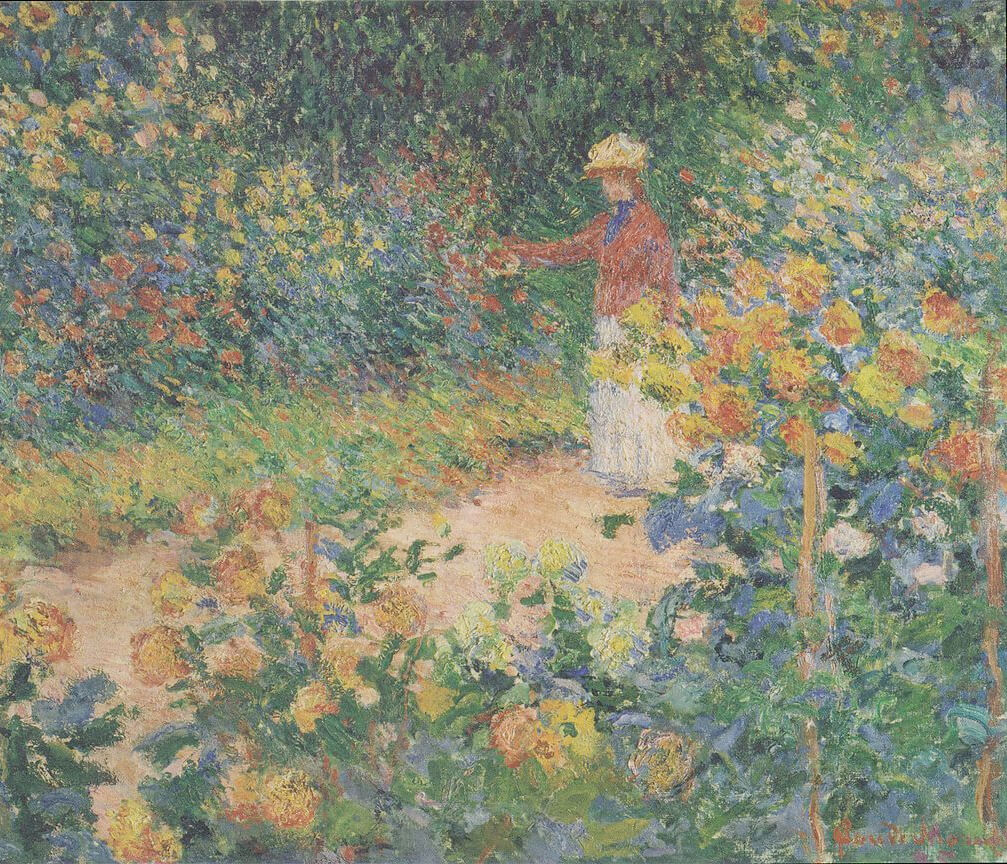
The School for Aromatic Studies Health Disclaimer
I am sure, like so many individuals throughout the world, you have experienced the beauty and health benefits of essential oils. We, at the School for Aromatic Studies, certainly believe that essential oils have a valuable place in our essential wellness box.
And many ask the staff or our instructors how essential oils may be used for specific ailments either they or someone in their family is experiencing. Due to legal and time restraints, the staff, instructors, and blog authors are unable to answer questions about specific health conditions.
The student forum may be used to discuss health related topics to share experiences with fellow students. Shared information through students does not represent the opinions of the school. We recommend avoiding direct health advice on the student forums. You are responsible for consulting a medical professional before trying any new herb or remedy mentioned in the website or any related forum.
The content on our website and in our online courses is for educational purposes only. We cannot diagnose health conditions, nor prescribe medicines legally; we are not medical doctors. However, we will recommend or suggest medicinal herbs for various health complaints, as we believe in the safety and efficacy of botanical medicine.
The information we provide is not intended to be a substitute for medical treatment. Please consult your medical or health care provider before using aromatherapy (particularly internally), or if you have a known medical condition or if you are pregnant or nursing.
We believe you are responsible for your own health.
Essential oils need to be used ethically and responsibly. The most common adverse side effects experienced from using essential oils include: dermal irritation, dermal sensitization, nausea, headaches, and dermal burning (e.g. the use of a photosensitizing oil such as bergamot – Citrus bergamia) and allergic reaction. Although these adverse events are generally extremely rare, it is important to know the safety of each essential oil you are using as well as the individual you may be using them with.
The School cannot predict how a remedy will work for you nor can we know the authenticity or quality of the essential oils being used. Always refer to your medical care provider for questions about your health.
Order Foundations Course Book
Order a hard copy of the
Foundations of Aromatherapy Certification Course. $72.00
NEW 2024! The Foundations of Aromatherapy course books have been printed in full color and include 3 soft-cover bound books.
The course book is a comprehensive compilation of all the pdf files from the course, presented in a visually appealing full-color softcover book.
It does not include quizzes.
*To order this textbook, You must be a student or graduate of the Foundations of Aromatherapy course.
Sprout: Legalities of Practice
Here is an insightful article about the legalities of practicing Herbalism. This article is very prevalent to the practice of aromatherapy as well particularly those who are not licensed in another field such as massage therapy, esthetics, nursing, etc.
Would love to hear your thoughts on this after you read it so be sure to post in the student forum! Thank you.
The right to practice herbology, legal history and basis
Here is a shorter version.
Read: The Aroma of Choice – Healthcare Freedom and Aromatherapy
Lesson 5b: Aromatic Diffusion
DIFFUSION
The word ‘diffusion’ is defined as the state of being spread out or transmitted, especially by contact, or the action of diffusing (to pour out and permit or cause to spread freely).
Diffusion, in our case, refers to a method of transmitting essential oils (volatile components) into the air within a specified area and for a specified reason/goal.
Diffusing essential oils into the environment can potentially offer a wide range of benefits, including:
- Reduce or alleviate stress and anxiety
- Relieve pain by altering pain perception (in the brain)
- Induce sleep or relaxation
- Increase alertness and overall performance
- Be used for weight control or loss
- Improved duration and patterns of sleeping
- Affect and improve mood and increase overall emotional well-being
- Ease physical ailments, particularly stress-related disorders
- Help shape our impressions of self and others
- A reduction of adrenal corticosteroid output to within normal parameters
- Reduction of blood pressure
- Increased concentration levels
- Immune response modulation
- Improved sense of well-being
- Great ability to cope with immediate or long-term stressors (Resiliency)
- Reduction in muscular tension
Methods of diffusion
Nebulizer Diffuser
A nebulizer diffuser consists of two main components: an air pump and a hand-blown glass expansion chamber (nebulizer). The glass chamber features special internal tubes and baffles that play a crucial role in the diffusion process. When the air pump pushes air into the glass chamber, the essential oil comes into contact with the baffles, causing it to ‘break’ and be discharged into the atmosphere as a fine mist of microdroplets. This process ensures an even and efficient distribution of the essential oil throughout the desired space.
The nebulizer diffuser is a more suitable tool for dispersing essential oils in traditional and nontraditional healthcare settings than candle diffusers or even ultrasonic diffusers.
Recommended Usage:
The traditional glass nebulizers are designed to have essential oils dropped into the glass piece. Typically, 20-30 drops are sufficient. Some modern nebulizers are designed to hold a 5ml bottle of an essential oil or essential oil synergy. Many also come with a timer as a part of the unit. Therefore, you can either use a single essential oil and attach it to the unit or make up a 5ml synergy to use.
Ultrasonic Diffuser
An ultrasonic diffuser uses ultrasonic vibrations to disperse essential oils (aromatics) and water into a fine mist. Unlike a nebulizing diffuser, it uses water to which essential oils are added.
How to Use:
- Remove the unit’s cover and add water to the container until it reaches the water marker.
- Add 5 to 12 drops of essential oils or synergy into the water.
- Replace the cover.
- Connect the unit to a power source.
- Turn the diffuser on.
- Select the desired time setting for the mist.
- LED light can be turned off independently.
How much essential oil to use in Ultrasonic diffusers
The standard recommendation is to add 5 to 12 drops of an essential oil or essential oil synergy (a combination of essential oils only) to the water. If you are diffusing in a room for an infant, try hydrosols or keep the drops at 5 or 6. If you are diffusing for adults only, I recommend going up to 10 or 12 drops, especially if you are going to run the diffuser for an hour. This will keep a consistent aroma in the air.
Clay candle or electric pottery diffusers
Clay candle and electronic pottery diffusers have a simple design and come in one or two pieces. They typically have an area on the top to place water and essential oil drops and an area beneath which holds a tea candle or electric heating system. They were once widely available from aromatherapy and other specialty suppliers; however, these days, the ultrasonic diffuser has risen in popularity. This type of diffuser provides a very simple and affordable method of environmental fragrancing that can be employed for home use. Most hospitals, hospices, and other healthcare facilities do not allow the use of candles in patient rooms.
Recommended Usage:
Place a small amount of water in the bowl or cup (top of diffusor) and add 5-10 drops of essential oil. Light a candle or plug in a diffuser.
Watch Video: Diffusing Essential Oils
PDF of Presentation: Diffusing Essential Oils
E-Book: Diffusing Essential Oils E-book
Supply List and Books
Supplies
Supply List for Foundations of Aromatherapy
24 Essential oils/size 5ml
- Clary Sage Salvia sclarea
- Roman Chamomile Chamaemelum nobile syn. Anthemis nobilis
- Cypress Cupressus sempervirens
- Eucalyptus Eucalyptus globulus
- Fennel Foeniculum vulgare
- Frankincense Boswellia carterii syn. sacra
- Geranium Pelargonium graveolens
- Ginger Root Zingiber officinale
- Grapefruit Citrus paradisi (pink or white)
- Helichrysum Helichrysum italicum
- Juniper Berry Juniperus communis
- Laurel Laurus nobilis
- Lavender Lavandula angustifolia
- Lemon Citrus limon
- Lemongrass Cymbopogon citratus
- Orange Citrus sinensis
- Patchouli Pogostemom cablin
- Peppermint Mentha x piperita
- Rosemary ct. cineole Rosmarinus officinale ct. cineole
- Scots Pine – Pinus sylvestris
- Tangerine/Mandarin Citrus reticulata
- Tea Tree Melaleuca alternifolia
- Vetiver Vetiveria zizanoides
- Ylang Ylang Complete Cananga odorata
Recommended Books
At this stage of your learning, we recommend the following book to support and enhance your learning of the course material:
- The Healing Intelligence of Essential Oils by Kurt Schnaubelt
How to Complete Program: Foundations
You’re ALMOST Done! You are now ready to complete the final requirements for the Foundations of Aromatherapy Certification Program.
As you learned in the Getting Started lesson in Module 1, to receive your certification, you will need to:
- Complete 5 case studies.
- Complete Final Exam.
In the next three sections are the following:
- How to do your case studies and documentation
- How to upload or send in your case studies
- Your final exam.
Please let us know if you have any questions. Good luck!!!
